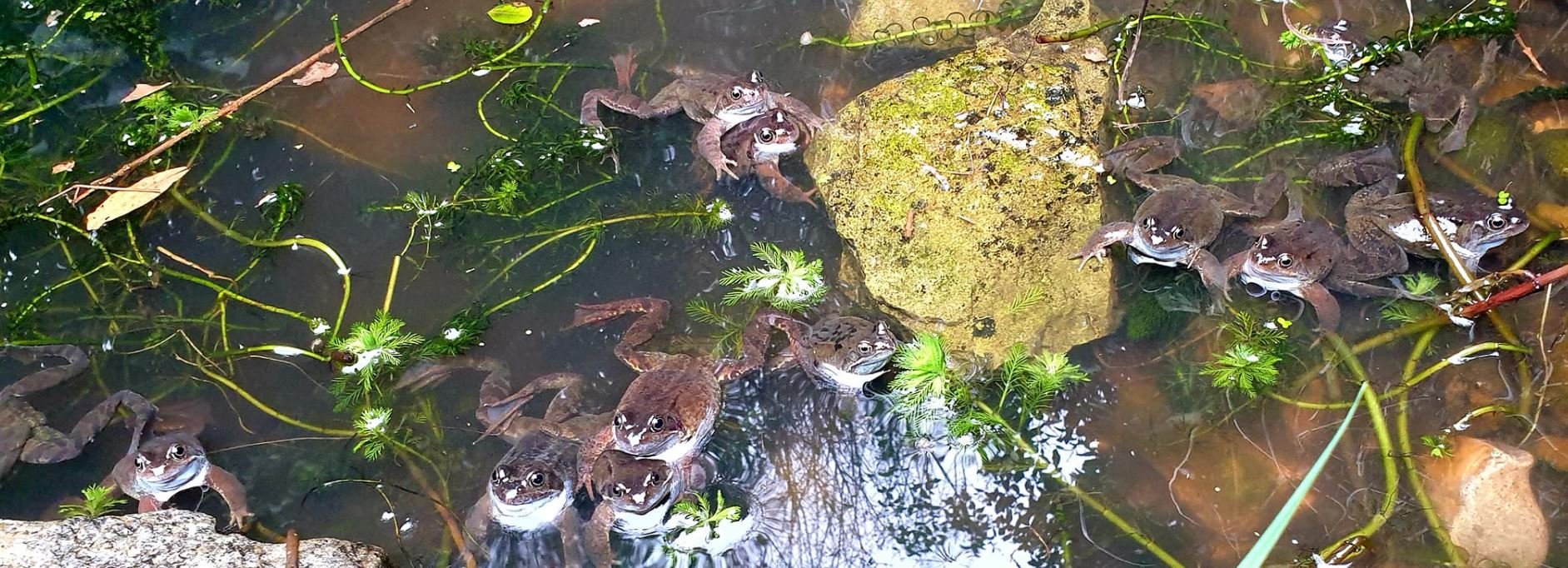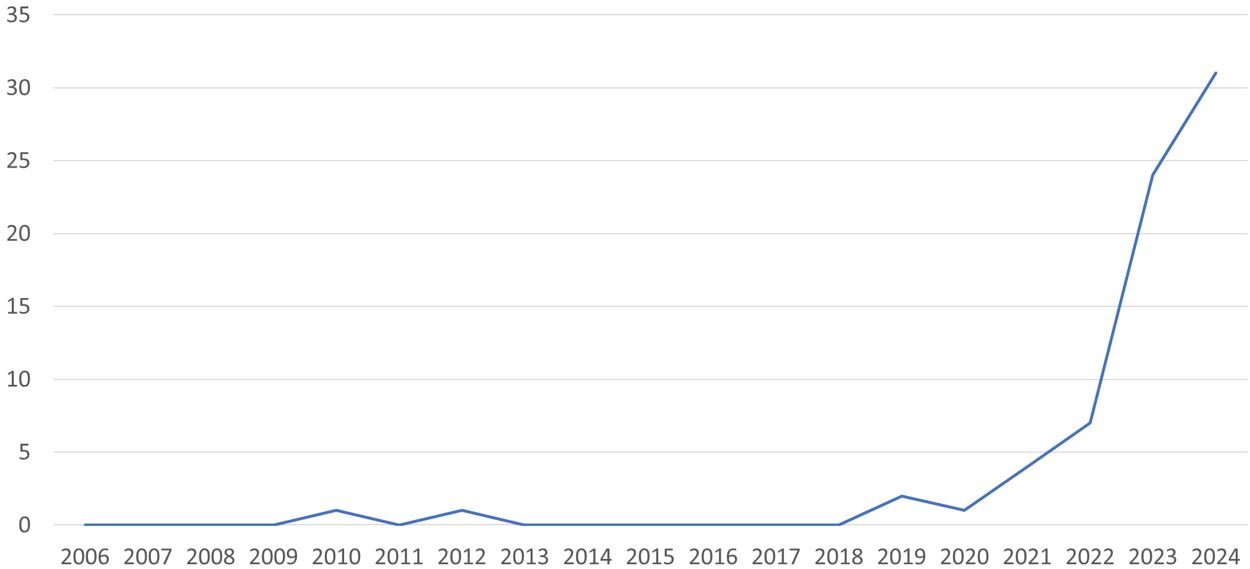Caption: the shallow end of pond 2 as of February 5th. When spawn is fresh, it’s tight, compact and rubbery, but as it matures its jelly absorbs water, expands and becomes much less firm. It’s possible to age the spawn by days and even hours (approximately) on the basis of its look. Image: Darren Naish.
Well, RIGHT NOW – early February – is the most exciting time of the year if you’re interested in explosively breeding frogs like R. temporaria, since this is the time when they suddenly appear in and around ponds, and then go about their competing and calling, and ultimately their spawning. Here’s a 2020 article on the Common frog and my efforts to boost their numbers and help them out.
I keep close tabs on all of this and report it on social media, and such is interest in this whole thing – I call it spawnwatch (with a hashtag where appropriate for social media) – that I’ve just decided to add things here at the blog too. But I’m going to do this in a slightly unusual fashion: I’m going to keep updating this article as long as there’s stuff worth talking about. Come back later to see what I mean!
Caption: these photos give you some idea of how packed things get, of how many frogs there are here. The image at right (taken from distance from an upstairs window) basically shows a massive brawling scrum of 30 or more frogs. Images: Darren Naish, Toni Naish.
Caption: it’s the 29th January and frogs are gathering for a weeks-long event. No spawn had appeared at this point. The shallow part of the pond at far right is where the frogs (mostly) spawn. No females are visible in this photo. Image: Darren Naish.
I’ll start by adding that we’re already about a week into spawnwatch. Frogs began gathering in late January, with the first spawn appearing on January 30th, this being the first time we’ve had a spawning in that month. Right now (5th February), there are at least 15 clutches. At least 24 appeared in 2023, so my assumption is that that number will be exceeded in 2024. There are likely more adult frogs in pond 2 (the main breeding pond here) here than last year: over 60, as opposed to around 50 in 2023. An issue I now see with pond 2 is that the shallow part of the pond (which is where frogs prefer to spawn) is not big enough for the amount of spawn we might get, meaning that some of it is being kicked into deeper water (where it won’t develop: it really needs to be at the surface to receive direct sunlight). I’m therefore removing some spawn into an adjacent large container that’s serving as a makeshift pond. I might modify the pond in future in view of this.
Caption: heavy frog activity on February 3rd. You’ll notice from these photos that individual frogs can be distinguished on the basis of their markings. I’m making an effort to identify individuals and monitor them year to year. Other such projects are underway elsewhere and very much ahead of me in terms of the data collected. Image: Darren Naish.
OK, enough for now… come back soon for updates added below. Oh, I’ve just returned from the Herpetofauna Workers Meeting 2024 (this year held in Whiteley, Hampshire), so have just spent the last few days immersed in the latest news on British and Irish herpetological science news, truly a fantastic meeting. Here are a few relevant scenes…
Caption: Chris Packham welcomes delegates to the Herpetofauna Workers Meeting 2024, this year held at Solent Hotel and Spa, Whiteley, Hampshire. Two days of talks, workshops and events on where we’re at with respect to work on newts, anurans and squamates of Britain and Ireland. Image: Darren Naish.
Caption: select images from the Herpetofauna Workers Meeting 2024. Many books were on sale, including from NHBS and Pelagic. I did something that I’m still trying to process and purchased the massive and substantial Salamanders & Newts of the World by Jean Raffaëlli. The card newt head was made during the quiz. I think you can agree that we done good (my team came third overall). Images: Darren Naish, Steve Allain.
UPDATE 1: we’re now up to 17 spawn clutches. But what’s interesting is that both new clutches are in unusual places relative to what the frogs seem to prefer: one is in open water in the middle of the pond (albeit on floating vegetation), and the other is at the heavily vegetated end of the pond (which is shallow, but not ideal as the water is always shaded, not in direct sunlight). I wonder if these clutches were laid where they were because the otherwise ideal shallow end is too packed full of busy, competing frogs?
On the subject of the shallow, busy end., I just watched and photographed a pair in amplexus move into the shallow end with seeming intent. I wondered if I might get to watch actual spawning happen (something I’ve never seen in person). The ‘elevated head’ posture maintained by the male is interesting: was he acting like this to intimidate other males and/or vocalize? Note also that the male is surprisingly plump. Come back for more updates soon…
UPDATE 2: the pond has been extremely active today (February 6th), and an additional five spawn clutches have appeared overnight, bringing us up to 22 clutches so far. 58 adult frogs were counted in the pond this morning, with at least some out of sight because they were submerged or in pond 1 when I was doing the count. I’ve seen two frog pairs still in amplexus, so there’s definitely more to come. I am also increasingly concerned that the shallow end of the pond – the part where the frogs want to spawn – is just not big enough for the number of frogs we have, and indeed one of the new spawn clutches is a second middle-of-pond one. There might still be a week or more of this yet to go! I’ll end with an updated version of the graph…
UPDATE 3: things have quieted down now (February 9th) and no new clumps have appeared over the past 24 hours, but this puts us at 24 clutches (the photo below was taken on Feb 8th). Part of the reason for the slow down is that it’s now rained continually for two straight days, and this has dampened the frogs’ enthusiasm for calling and competing at the water’s edge. The substantial amount of rain has also raised the level of the pond by about 10 cm, which is not great because the shallow edges they prefer for spawning are no longer as shallow. So that might be about it…but stay tuned, I’ll report what happens next.
UPDATE 4: things have essentially wound down, with no new spawn having appeared for the past two days. The final count is 27 clutches as of Feb 13th, and below you can see the resulting graph. Given that several frogs are still hanging around in the pond, it’s not impossible that more spawn clutches will appear, but croaking is no longer occurring and there are never more than five or six frogs visible above the surface. In years past, spawning usually occurred on or after Valentine’s Day (Feb 14th), yet this year the main event occurred a week before this, all of which is consistent with national trends: frogs across the UK now spawn at least one (and often two) weeks earlier in the year than they did approximately five years ago. This appears correlated with increasing average temperatures.
I think that this is likely to be the last update; to those who did so, many thanks for coming back to check things as they got posted. UPDATE! Another clutch has appeared as of 14th February, bringing the total to 28. The graph below is a new one that takes account of this. UPDATE!! More clutches have appeared since Feb 14th, the newest (at the time of writing) being on February 22nd. This has taken us to 31 clutches. And thus another new graph has been created…
For previous Tet Zoo articles on frogs, see…
Green-boned glass frogs, monkey frogs, toothless toads, November 2007
In pursuit of Romanian frogs (part III: brown frogs), August 2011
The toads series comes to SciAm: because Africa has toads too, September 2011
20-chromosome toads, September 2011
Glassfrogs: translucent skin, green bones, arm spines, January 2013
Everybody loves glassfrogs, February 2013
African tree toads, smalltongue toads, four-digit toads, red-backed toads: yes, a whole load of obscure African toads, December 2014
Gladiatorial glassfrogs, redux, January 2015
Frogs you may not have heard of: Brazil’s Cycloramphus ‘button frogs’, January 2015
It's the Helmeted water toad… this time, with information!, January 2015
The Terrible Leaf Walker Frog, March 2017
A Love Letter to the Common Frog, August 2020
What, If Anything, Is A Strabomantid? January 2024
Small Obscure African Toads; Toads Part 14, January 2024















